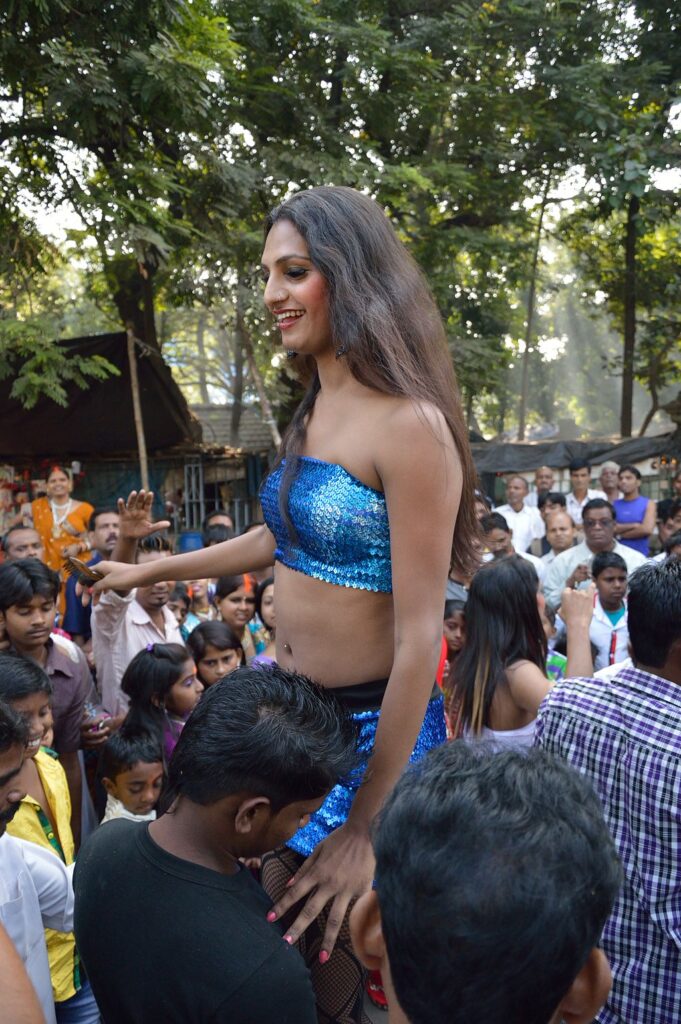What is Gender?
Gender refers to the behaviours, characteristics, roles, expressions, and norms that a culture associates with being a man, woman, or another gender [1].
Gender is how cultures expect people to be based on their sex, their gender identity, and/or their gender expression (see below for definitions of these terms). This means that gender is influenced by a culture’s ideas about what it means to be a man, woman, or another gender. As a result, people’s understanding of gender, as a concept, can be different from one culture to another as well as change over time [1,2].
[1] Government of Canada. (2023, May 8). What is gender? What is sex?. Canadian Institutes of Health Research. https://cihr-irsc.gc.ca/e/48642.html
[2] World Health Organization (WHO). (2021, May 24). Gender and health. World Health Organization. https://www.who.int/news-room/questions-and-answers/item/gender-and-health

File:Dancing Hijra – Chhath Festival – Strand Road – Kolkata 2013-11-09 4224 (c) Biswarup Ganguly, CC BY 3.0 DEED

Thailand 🇹🇭. (c) wildirishman37, Special Permission Granted by Photographer
What is Gender Identity?
Gender identity is how someone sees themself in relation to the concept of gender within their culture [1].
It is someone’s personal sense and experience of their own gender. It is what a person feels their gender is [1]. There are many biological, psychological, and social factors that come together to influence a person’s gender identity [2]. Someone’s gender identity can be the same or different from the one that is associated culturally with their sex [1,3]. For some, gender identity stays relatively the same throughout life. For others, gender identity can change with time [4].
[1] World Health Organization (WHO). (2021, May 24). Gender and health. World Health Organization. https://www.who.int/news-room/questions-and-answers/item/gender-and-health
[2] McGuire, J., de Vries, A., Kreukels, B., & Steensma, T. (2014). Gender Identity Development: A Biopsychosocial Perspective. In Gender Dysphoria and Disorders of Sex Development (pp. 53–80). Springer US. https://doi.org/10.1007/978-1-4614-7441-8_3
[3] U.S. Department of Health and Human Services. (n.d.). Sex & gender. National Institutes of Health: Office of Research on Women’s Health. https://orwh.od.nih.gov/sex-gender
[4] Lindqvist, A., Sendén, M. G., & Renström, E. A. (2021). What is gender, anyway: a review of the options for operationalising gender. Psychology and Sexuality, 12(4), 332–344. https://doi.org/10.1080/19419899.2020.1729844
What is Gender Expression?
Gender expression is how someone shows or communicates their gender identity [1,2].
The way people express their gender identity can include what kind of clothes they wear, the way their hair is cut, how they act, the way they talk, and/or the interests they have. Cultures can have different ideas about how gender is or should be expressed based on a person’s gender identity. However, a person’s gender expression can be different from what their culture(s) expects it to be. For instance, a culture may expect all women to have long hair. But a person can have short hair and still identify as a woman. As a result, a person’s gender identity is not always known based on the ways they express their gender [1,3].
[1] World Health Organization (WHO). (2021, May 24). Gender and health. World Health Organization. https://www.who.int/news-room/questions-and-answers/item/gender-and-health
[2] Olson, K. R., Durwood, L., DeMeules, M., & McLaughlin, K. A. (2016). Mental Health of Transgender Children Who Are Supported in Their Identities. Pediatrics (Evanston), 137(3), e20153223-. https://doi.org/10.1542/peds.2015-3223
[3] Aleshire, M. E. (2016). Sexual Orientation, Gender Identity, and Gender Expression: What Are They? Journal for Nurse Practitioners, 12(7), e329–e330. https://doi.org/10.1016/j.nurpra.2016.03.016

MX MR 4A VELA MUXE GUUCHACHI 2016 (c) Secretaría de Cultura CDMX, CC BY-SA 2.0 DEED
What is not Gender, Gender Identity, or Gender Expression?
Gender and sex are often thought to have the same meaning, but they are not the same thing [1-3].
Whereas gender relates to a society’s idea of being a woman, man, or another gender, sex refers to a group of biological traits, which include chromosomes, reproductive and sexual anatomy, gene expression, and hormone levels and functions [1,2].
Based on their sex traits, people are usually assigned male or female at birth. However, there are variations in sex characteristics and how they are expressed [1-3]. As stated by the National Institutes of Health’s Office of Research on Women’s Health, those with sex traits that differ from “…traditional definitions of male or female…” are considered intersex [2,3].
Sexual orientation is someone’s pattern of emotional, physical, romantic, and/or sexual attraction for others. In other words, sexual orientation is who someone is attracted to. A person’s sexual orientation can include being attracted to only one gender, multiple genders, or no gender at all [1,4,5].
Most people’s sexual orientation stays stable over their lifetime [5]. However, some people also experience changes in their sexual orientation over time [6].
While a person’s gender identity, gender expression, and sex can influence a person’s sexual orientation, these traits are not strictly related to someone’s sexual orientation [1].
[1] World Health Organization (WHO). (2021, May 24). Gender and health. World Health Organization. https://www.who.int/news-room/questions-and-answers/item/gender-and-health
[2] Government of Canada. (2023, May 8). What is gender? What is sex?. Canadian Institutes of Health Research. https://cihr-irsc.gc.ca/e/48642.html
[3] U.S. Department of Health and Human Services. (n.d.). Sex & gender. National Institutes of Health: Office of Research on Women’s Health. https://orwh.od.nih.gov/sex-gender
[4] Aleshire, M. E. (2016). Sexual Orientation, Gender Identity, and Gender Expression: What Are They? Journal for Nurse Practitioners, 12(7), e329–e330. https://doi.org/10.1016/j.nurpra.2016.03.016
[5] Anderson, E., & McCormack, M. (2016). The Changing Dynamics of Bisexual Men’s Lives: Social Research Perspectives. Springer International Publishing.
[6] American Psychological Association. (2012). Guidelines for Psychological Practice With Lesbian, Gay, and Bisexual Clients. The American Psychologist, 67(1), 10–42. https://doi.org/10.1037/a0024659

Frogs, Dog, and Non-Binary Fan 1 (c) crudmucosa, CC BY 2.0 DEED

June Park, Artist (c) Oregon State University, CC BY-SA 2.0 DEED
Aren't there only two genders?
When we think about gender, we usually only think of cisgender men or women, whose gender identities are the same as their gender given at birth [1].
But, for many different cultures, there are more than just those two categories [2]. There are more than several dozen cultures known to recognize gender categories that are neither man nor woman [3].
For instance, in Western cultures, such as in Canada or the United States, there is growing recognition of non-binary gender identities, which are genders beyond the categories of man or woman [4]. An example of a non-binary gender identity is agender, which means to be without gender or genderless [5]. Another example is gender fluid, which describes people whose gender is not fixed but rather changes across time and/or situations [6].
Non-binary gender identities fall under the umbrella term of transgender, which describes people whose gender identity is different from their gender given at birth [7]. But not all transgender people have non-binary gender identities. For example, a person can be transgender and have a gender identity that is man or woman, which are both traditional binary gender identities [8].
[1] Tate, C. (2017). Cisgender. In K.L. Nadal (Ed.), The SAGE Encyclopaedia of Psychology and Gender. SAGE Publications.
[2] Brown, J. & Kelly, R. (2017). Cross-Cultural Models Or Approaches To Gender. In K.L. Nadal (Ed.), The SAGE Encyclopedia of Psychology and Gender. SAGE Publications.
[3] VanderLaan, D. P., Ren, Z., & Vasey, P. L. (2013). Male Androphilia in the Ancestral Environment: An Ethnological Analysis. Human Nature (Hawthorne, N.Y.), 24(4), 375–401. https://doi.org/10.1007/s12110-013-9182-z
[4] Vincent, B., & Barker, M. (2021). Nonbinary genders. In The SAGE Encyclopedia of Trans Studies (Vol. 2, pp. 573-578). SAGE Publications, Inc., https://doi.org/10.4135/9781544393858
[5] Siegel, D., & Galupo, M. (2021). Agender people. In The SAGE Encyclopedia of Trans Studies (Vol. 2, pp. 21-22). SAGE Publications, Inc., https://doi.org/10.4135/9781544393858
[6] Parsa, N., & Katz-Wise, S. (2021). Gender fluidity. In The SAGE Encyclopedia of Trans Studies (Vol. 2, pp. 304-305). SAGE Publications, Inc., https://doi.org/10.4135/9781544393858
[7] Tate, C. (2017). Transgender People. In K.L. Nadal (Ed.), The SAGE Encyclopedia of Psychology and Gender. SAGE Publications.
[8] The Rainbow Project. (2023, January 19). What we do mean by trans or non-binary?. The Rainbow Project. https://www.rainbow-project.org/what-we-do-mean-by-trans-or-non-binary/
Understanding Non-Binary: Excerpts from a Correspondence | Robbin Derry and Saga Darnell | TEDxULeth by TEDx Talks
5 Non-Binary People Explain What “Non-Binary” Means To Them by Tinder
“In my day, you were butch or you were femme” by Annie Tritt (2020), published on Vox
9 questions about gender identity and being transgender you were too embarrassed to ask by German Lopez (2017), published on Vox
‘I’ve always known I was different’: Four trans people share their stories by Casey Parks, published on The Washington Post
Not all cultures think about gender the same way...
Ideas about gender can be different from one culture to the next [1].
People may understand and talk about gender in a way that is unique to their culture and/or community [1]. Also, gender terms and labels from Western cultures may not be used in other parts of the world. As a result, it is important to not assume that Western ideas and terms about gender are the same as those used in other cultures around the world. Instead, culturally specific ideas and terms about gender should be used whenever possible [2].
[1] Mazzuca, C., Borghi, A. M., van Putten, S., Lugli, L., Nicoletti, R., & Majid, A. (2023). Gender is conceptualized in different ways across cultures. Language and Cognition, 1–27. https://doi.org/10.1017/langcog.2023.40
[2] Chadwick, C. & DeBlaere, C. (2017). Third Gender. In K.L. Nadal (Ed.), The SAGE Encyclopedia of Psychology and Gender. SAGE Publications.
